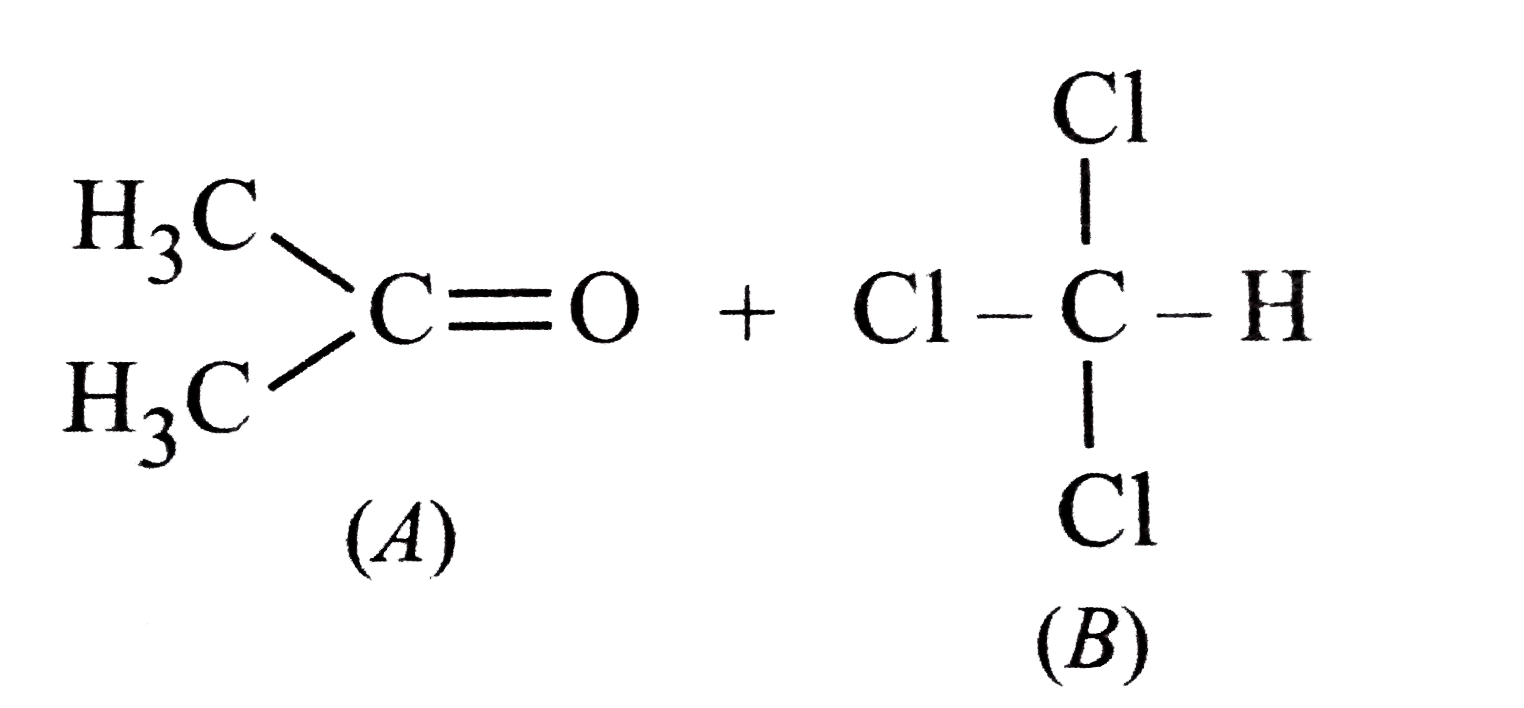Acetone and chloroform reacts to produce
CH3COOC2H5
CH3CHO
(CH3)2C(OH)CCI3
HCHO
The correct Answer is:C
To determine the product formed from the reaction between acetone and chloroform, we can follow these steps:
Step 1: Identify the Reactants
- Acetone (CH₃COCH₃) is a ketone with the structure:
CH3−C(O)−CH3
- Chloroform (CHCl₃) is a haloalkane with the structure:
CHCl3
Step 2: Understand the Reaction Mechanism
- Chloroform contains a hydrogen atom that is acidic due to the presence of the electronegative chlorine atoms.
- In the presence of a base, the acidic hydrogen (H) from chloroform can be removed, resulting in the formation of a chloroform anion (CCl₃⁻).
Step 3: Formation of the Enolate Ion
- The acetone can undergo deprotonation at one of its methyl groups in the presence of a strong base, forming an enolate ion:
CH3−C(O)−CH3→CH−2−C(O)−CH3
Step 4: Nucleophilic Attack
- The enolate ion formed from acetone can act as a nucleophile and attack the carbon of the chloroform, resulting in the formation of a new carbon-carbon bond:
CH−2−C(O)−CH3+CCl3→C(CCl3)(OH)−C(O)−CH3
Step 5: Final Product Formation
- The final product will have a carbon atom bonded to a hydroxyl group (OH) and a trichloromethyl group (CCl₃) along with the remaining acetone structure:
C(CCl3)(OH)−C(O)−CH3
Conclusion
The product formed from the reaction of acetone and chloroform is:
C(CCl3)(OH)−C(O)−CH3
- Acetone (CH₃COCH₃) is a ketone with the structure:
CH3−C(O)−CH3
- Chloroform (CHCl₃) is a haloalkane with the structure:
CHCl3
- Chloroform contains a hydrogen atom that is acidic due to the presence of the electronegative chlorine atoms.
- In the presence of a base, the acidic hydrogen (H) from chloroform can be removed, resulting in the formation of a chloroform anion (CCl₃⁻).
- The acetone can undergo deprotonation at one of its methyl groups in the presence of a strong base, forming an enolate ion:
CH3−C(O)−CH3→CH−2−C(O)−CH3
- The enolate ion formed from acetone can act as a nucleophile and attack the carbon of the chloroform, resulting in the formation of a new carbon-carbon bond:
CH−2−C(O)−CH3+CCl3→C(CCl3)(OH)−C(O)−CH3
- The final product will have a carbon atom bonded to a hydroxyl group (OH) and a trichloromethyl group (CCl₃) along with the remaining acetone structure:
C(CCl3)(OH)−C(O)−CH3
The product formed from the reaction of acetone and chloroform is:
C(CCl3)(OH)−C(O)−CH3
Topper's Solved these Questions
- BOOK - ERRORLESS CHAPTER - ALDEHYDES AND KETONES EXERCISE - Critical Thinking Objective Questions21videos
ALDEHYDES AND KETONES
- BOOK - ERRORLESS CHAPTER - ALDEHYDES AND KETONES EXERCISE - JEE Section Only one choice correct answer39videos
ALDEHYDES AND KETONES
- BOOK - ERRORLESS CHAPTER - ALDEHYDES AND KETONES EXERCISE - Ordinary Thinking (Objective Questions) Preparation43videos
ALDEHYDES AND KETONES
- BOOK - ERRORLESS CHAPTER - ALCOHOL, PHENOL AND ETHEREXERCISE - JEE SECTION (JEE Advanced 2018) More than one choice correct answer1videos
ALCOHOL, PHENOL AND ETHER
- BOOK - ERRORLESS CHAPTER - ANALYTICAL CHEMISTRYEXERCISE - JEE Section (Only One Choice Answer)36videos
ANALYTICAL CHEMISTRY
Similar Questions
Knowledge Check
- Question 1 - Select One
When acetone and chloroform are mixed, hydrogen bonding takes place between them. Such a liquid pair will cause
APositive deviation from Raoult's law.BNegative deviation from Raoult's law.CNo deviation from Raoult's law.DCannot be predicted. - Question 2 - Select One
When acetone and chloroform are mixed, hydrogen bonding takes placce between them, such a liquid pair will cause :
Apositive deviation from Raoult's lawBnegative deviation from Raoult's lawCno deviation from Raoult's lawDcannot be predicted - Question 3 - Select One
When acetone and chloroform are mixed together , hydrogen bonds are formed between them. Which of the following statements is correct about the solution made by mixing acetone and chloroform ?
AOn mixing acetone and chloroform will form an ideal solutionBOn mixing acetone and chloroform positive deviation is shown since the vapour pressure increasesCOn mixing acetone and chloroform negative deviation is shown since there is decreae in vapour pressureDAt a specific composition acetone and chloroform will form minimum boiling azeotrope
Name the product obtained when chloroform reacts with (a) nitric acid (b) silver powder (C) aniline in the presence of alcoholic KOH (d) acetone.
View SolutionWhen acetone and chloroform are mixed together, which of the following observations is correct ?
 View Solution
View SolutionWhen acetone and chloroform are mixed together, H - bonding takes place between them. Such a liquid pair shows
View SolutionThe chloroform reacts with NaOH to give
View Solution(A) The dissolution of acetone in chloroform is an exothermic process.
(R) H-bonding occurs between acetone and chloroform molecules on mixing the two.View Solution

